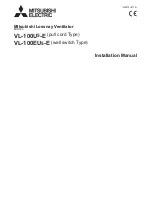
TECHNICAL AND MAINTENANCE MANUAL
Graph VENTILATOR
Review : 04
Date: 09/05/06
30
TROUBLE SHOUTING
PROBLEM
POTENTIAL CAUSE
CORRECTIVE ACTION
Low Tidal Volume
1. Incorrect initial calibration of
the patient’s circuit.
2. Damaged expiratory valve
or expiratory
pneumotachograph.
3. Disconnection of the lower
hose of the expiratory
pneumotachograph.
4. Obstruction of P1.
5. Damaged flow sensors.
1. Redo initial calibration of the circuit.
2. Check expiratory valve and
pneumotachograph.
3. Check connections of the expiratory
pneumotachograph.
4. Check permeability of P1.
5. Check flow sensors.
High Tidal Volume
1. Incorrect initial calibration.
2. Damaged expiratory
pneumotachograph.
3. Obstruction of P2.
4. Reversed connection of P1
and P2.
5. Damaged flow sensors.
1. Redo initial calibration.
2. Check pneumotachograph.
3. Check permeability of P2.
4. Check if P1 and P2 are correctly
connected (check they are not
inverted).
5. Check the operation of the flow
sensors.
High Inspiratory
Pressure
1.
Occlusion of the patient’s
circuit.
2. High volume.
3. High rise time.
4. High inspiratory flow.
5. Decalibrated flow sensor.
1.
Check the patient’s circuit.
2. Check the volume.
3. Regulate Rise Time according to the
patient’s resistance.
4. Complete calibration of the device.
5. Check complete calibration of the
device.
Low Inspiratory
Pressure
1. Disconnection of the upper
hose of the expiratory
pneumotachograph.
2. Internal disconnection of the
flow sensor.
3. Damaged flow sensor.
1. Check connections of the expiratory
pneumotachograph.
2. Check connections of the internal
pneumatic circuit.
3. Check the flow sensor.
High Minute
Volume
1. Disconnection of the upper
hose of the
pneumotachograph.
2. Obstruction of P2.
3. Reversed connection of P1
and P2.
4. Damaged flow sensors.
1. Check connections of the expiratory
pneumotachograph.
2. Check permeability of P2.
3. Check if P1 and P2 are correctly
connected (check they are not
inverted).
4. Check flow sensors.
Low Minute Volume
1. Obstruction of P1 or P2.
2. Damaged flow sensors.
3. Altered
pneumotachographs.
1. Check permeability of P1 and P2.
2. Check flow sensors.
3. Ensure there is no water in the
device, and recalibrate the device
completely.
There is no PEEP
1. Damaged expiratory valve.
2.
Leaks in the patient’s circuit.
3. Defective PEEP
electrovalve.
4. Water in the PEEP
electrovalve.
1. Check expiratory valve.
2.
Check the patient’s circuit.
3. Check operation of the PEEP
electrovalves in the sensors board.
4. Check if water has entered into the
pneumatic box. If water has entered
into the valves, replace the PEEP
electrovalve.
Summary of Contents for NEUMOVENT
Page 1: ...Graph ventilator Technical manual review 04 MAY 2006 ...
Page 3: ...CHAPTER I GENERAL AND OPERATION FEATURES ...
Page 12: ...TECHNICAL AND MAINTENANCE MANUAL Graph VENTILATOR Review 04 Date 09 05 06 9 ...
Page 13: ...TECHNICAL AND MAINTENANCE MANUAL Graph VENTILATOR Review 04 Date 09 05 06 10 ...
Page 30: ...CHAPTER II MAINTENANCE INSTRUCTIONS ...
Page 32: ...CHAPTER III TROUBLE SHOOTING ...
Page 37: ...CHAPTER IV SENSOR VERIFICATION ...
Page 44: ...CHAPTER V EQUIPMENT OPENING AND CLOSURE ...
Page 60: ...CHAPTER VI DETAIL OF ASSEMBLIES ...
Page 70: ...CHAPTER VII ELECTRONIC BOARDS DETAIL ...
Page 78: ...CHAPTER VIII CALIBRATION ...
Page 90: ...CHAPTER IX FINAL CONTROL ...















































